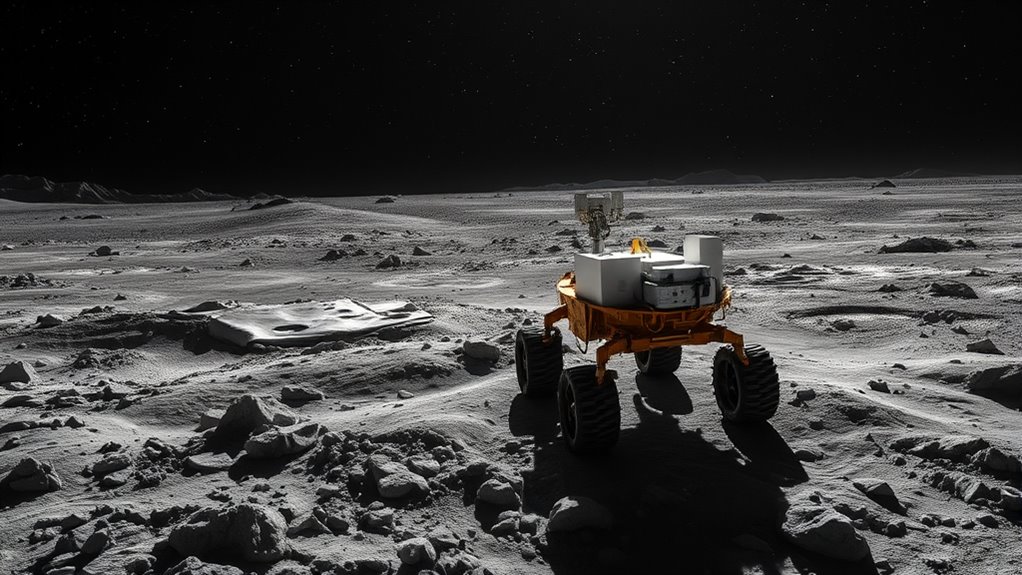China’s lunar rover has made an unexpected discovery of unusual mineral deposits on the Moon’s far side, revealing a more complex geological history than scientists believed. This breakthrough offers new insights into lunar surface processes and composition, challenging existing theories. Traveling the rugged terrain and communicating across the far side posed significant challenges, but the rover’s success showcases advanced engineering and innovation. Continue exploring to find out how this discovery could reshape our understanding of the Moon’s past.
Key Takeaways
- China’s lunar rover discovered unusual rock formations and mineral deposits on the Moon’s far side, indicating a complex geological history.
- The findings challenge existing lunar formation theories and suggest new insights into the Moon’s interior and volcanic activity.
- Navigating the rugged terrain and communication delays demonstrated advanced engineering and autonomous capabilities of the rover.
- The discovery highlights the importance of exploring hidden lunar regions for scientific breakthroughs and resource potential.
- Data from the mission could reshape current models of lunar evolution and inform future exploration and colonization efforts.

China’s lunar rover has made an unexpected discovery on the Moon’s far side, revealing new insights into the lunar surface. This breakthrough could markedly advance our understanding of lunar geology and the Moon’s history. As you explore this news, it’s essential to recognize the unique challenges that space exploration presents, especially on the far side of the Moon, which remains hidden from direct Earth communication. Despite these obstacles, China’s rover has managed to collect data that could reshape existing theories about lunar formation and composition.
China’s rover uncovers new lunar surface insights, challenging existing theories about the Moon’s formation and composition.
The discovery centers around unusual rock formations and mineral deposits that differ from what scientists previously observed on the near side. These findings suggest that the Moon’s far side might host a more complex geological history than originally thought. You might think of lunar geology as a puzzle, with each new piece revealing more about the Moon’s evolution. This mission’s success highlights the importance of exploring regions that are difficult to access due to communication delays and terrain obstacles. The rugged landscape and thick crust of the far side pose considerable challenges, requiring advanced technology and careful planning. Yet, China’s rover navigates these hurdles, sending back valuable images and samples that deepen our understanding of lunar surface processes.
This discovery also underscores how space exploration challenges extend beyond just reaching the Moon. You face issues like maintaining communication links, ensuring rover durability in extreme temperatures, and overcoming unpredictable terrain. The far side’s rugged topography complicates navigation, making each maneuver a test of engineering ingenuity. Still, the scientific potential outweighs these difficulties, especially when uncovering secrets about the Moon’s interior and surface history. By studying the mineral composition and geological features, scientists can better understand the Moon’s past volcanic activity, impact history, and crustal structure. Additionally, advancements in AI security can help improve autonomous systems in future space missions, enhancing data collection and analysis capabilities.
Your curiosity is piqued as you realize that each new discovery on the lunar surface pushes the boundaries of what’s possible in space exploration. This achievement exemplifies how persistence and innovation help overcome the inherent challenges of exploring an alien landscape. The insights gained could inform future missions, including potential lunar bases or resource extraction. As you follow this story, remember that every piece of data collected not only broadens scientific knowledge but also demonstrates humanity’s resilience in exploring the unknown. China’s success on the Moon’s far side is a testament to how pushing past space exploration challenges can lead to extraordinary discoveries about our celestial neighbor.
Frequently Asked Questions
How Does the Lunar Rover Communicate With Earth on the Far Side?
You rely on a satellite relay system to communicate with the lunar rover on the far side of the Moon. The relay satellite orbits between the Moon and Earth, transmitting signals back and forth. This setup helps you manage the signal delay caused by the vast distance, ensuring continuous communication. Without it, direct contact would be impossible due to the Moon’s terrain blocking signals from reaching Earth directly.
What Specific Technology Enabled the Rover’s Unexpected Discovery?
You find that the rover’s unexpected discovery was enabled by advanced instrumentation that allows precise remote sensing. This technology helps you analyze the moon’s surface in detail, revealing features and materials that weren’t previously known. The sophisticated sensors detect subtle variations in composition and topography, providing critical data. This combination of remote sensing and advanced instrumentation empowers you to make groundbreaking discoveries, even from afar, broadening our understanding of the moon’s far side.
Are There Plans to Send Humans to Explore the Discovery Site?
Yes, there are plans for human exploration at the discovery site, driven by recent technological advancements. These advancements enable more precise and safe missions, allowing you to explore the lunar surface firsthand. Human exploration will deepen our understanding of the moon’s far side, and future missions will likely focus on scientific research and potential resource utilization. With ongoing technological progress, you can expect increasingly ambitious lunar exploration efforts.
How Does This Discovery Impact Future Lunar Research Missions?
Imagine lunar geology suddenly throwing a curveball—your exploration strategies must adapt. This discovery pushes future lunar research missions to reconsider their approach, focusing more on remote sensing and robotic exploration. It signals that the far side still holds secrets, prompting you to prioritize innovative tools over traditional manned missions. In short, your plans will evolve, embracing new tech and strategies to unseal the Moon’s hidden mysteries.
What Challenges Did the Rover Face While Operating on the Moon’s Far Side?
You encounter several challenges while operating on the moon’s far side. The rugged lunar terrain makes navigation difficult, risking the rover’s stability and data collection. Communication delays, caused by the moon’s position blocking direct signals, hinder real-time control, forcing you to rely on autonomous systems. These obstacles demand careful planning, robust technology, and adaptive strategies to guarantee the rover’s success in exploring this remote, unexplored region.
Conclusion
So, what does this surprise discovery mean for you? It’s a reminder that even in the vastness of space, there’s always more to learn and explore. Your curiosity fuels these incredible missions, pushing boundaries and uncovering secrets hidden on the moon’s far side. As China’s rover continues its journey, you can’t help but wonder—what other mysteries are waiting to be uncovered out there? The universe is full of surprises, and you’re part of this exciting adventure.









